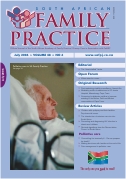Screening for diabetes mellitus in learners residing in the Belhar, Delft and Mfuleni communities of Cape Town, Western Cape, South Africa
Abstract
Background Historically, children and adolescents have been diagnosed with type 1 diabetes mellitus and it was thought that type 2 diabetes mellitus occurred only in adults. There are increasing reports of type 2 diabetes in children globally, with some as young as eight years old being affected. The average age of diagnosis in this group was 13 years. This has been attributed to the “epidemic of overweight and obesity currently being observed in both developed and developing countries. There is a paucity of data on the incidence and prevalence of type 2 diabetes mellitus in children compared with that for adults. Most studies reported to date have been clinic based. The few population-based studies that were carried out between 1965 and 1995 have shown a several-fold increase in the incidence rates of type 2 diabetes mellitus. The prevalence of diabetes mellitus in South Africa has risen dramatically in the past two decades, with the highest prevalence rates being found in the adult population of Indian origin, followed by the African, Coloured (mixed ancestry) and White population groups. Objectives This study was undertaken to screen 10 to 16-year-old learners residing in three urban areas of Cape Town, South Africa for diabetes mellitus. Methods Fasting and casual blood glucose levels were measured using a commercial glucometer in 338 randomly selected schoolchildren aged from 10 to 16 from the urban communities of Belhar, Delft and Mfuleni in Cape Town. Early morning urine samples were also tested for the presence of glucose using dipsticks. Anthropometric measurements were carried out using standard procedures. A structured questionnaire on physical activity, demographics and diabetic status was administered to all participants. Overweight and obesity were estimated according to The International Obesity Task Force (IOTF) criteria. Results A total of 15.7% of the learners were overweight and 6.2% were obese; 11.5% of the learners had a first-degree relative with diabetes and 29.9% had a second-degree relative with diabetes. Mean fasting and casual glucose values of 4.26 ± 0.63 mmol/l and 4.58 ± 0.79 mmol/l (p <0.05) respectively were obtained. Using the American Diabetes Association (ADA) criteria, no learner was found to be diabetic or presented with elevated blood glucose concentrations. No learner presented with glycosuria. Females had marginally higher fasting and casual glucose levels than males, although the difference was insignificant. The overall (fasting and casual) glucose levels in African (4.37 ± 0.67 mmol/l) and Coloured learners (4.48 ± 0.79 mmol/l) were similar, with no gender differences being observed between the two groups. Blood glucose values were similar in those with or without a family history of diabetes. Fasting and casual blood glucose values were also similar between overweight, obese or normal weight learners and were not influenced by body mass index. Conclusion These results suggest that population screening of children may not be viable, despite the increase in the prevalence of diabetes mellitus amongst various racial groups in South Africa. SA Fam Pract 2006;48(6): 16)
Issue
Section
Original Research
By submitting manuscripts to SAFP, authors of original articles are assigning copyright to the South African Academy of Family Physicians. Copyright of review articles are assigned to the Publisher, Medpharm Publications (Pty) Ltd, unless otherwise specified. Authors may use their own work after publication without written permission, provided they acknowledge the original source. Individuals and academic institutions may freely copy and distribute articles published in SAFP for educational and research purposes without obtaining permission.

